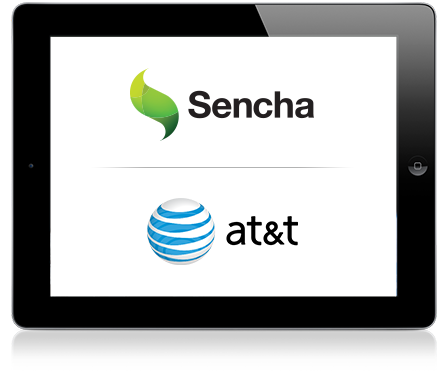Announcing AT&T API Platform SDK 2.1
Introduction

Sencha is pleased to announce the release of the latest version of our SDK that allows developers to utilize AT&T APIs from within an HTML5 application.
This release of the SDK builds upon the previous release by including Sencha Touch 2 and adding access to new APIs such as Speech and In App Messaging from Mobile Number (Beta).
SDK Contents
The kit is available from the AT&T Developer Program website and contains the required classes to include in your Sencha Touch application. Required gateway server software is also provided in three popular languages—Ruby on Rails, Java, and PHP—with detailed documentation on installation and configuration of each server.
The SDK makes use of Ext.Direct to communicate with the server which acts as a gateway between your Sencha Touch application running on a user client, and the AT&T API servers.
Getting Started
As with the previous version of the SDK, you will need to download and unpack the kit into your development environment. Note that this SDK is not backwards compatible with the previous version, so any application you have already created needs to be upgraded to Sencha Touch 2. For information about migrating your applications from ST 1 to ST 2 please review our migration guide.
New APIs
AT&T has introduced a few new APIs in this release which are quite exciting and open up a world of possibilities for your application.
![]() The Speech API allows you to send an audio file to AT&T where it will analyze and convert the audio to text. It is optimized to transcribe speech to text for numerous contexts, allowing it to return more accurate results.
The Speech API allows you to send an audio file to AT&T where it will analyze and convert the audio to text. It is optimized to transcribe speech to text for numerous contexts, allowing it to return more accurate results.
![]() In App Messaging from Mobile Number (Beta) allows users to send text and picture messages from within your app to any U.S. mobile phone using their own AT&T phone number.
In App Messaging from Mobile Number (Beta) allows users to send text and picture messages from within your app to any U.S. mobile phone using their own AT&T phone number.
Existing APIs
In addition to the new APIs introduced above, AT&T has a strong suite of APIs available on the AT&T Platform.
![]() SMS, Short Messaging Service—send texts from your application to AT&T wireless customers.
SMS, Short Messaging Service—send texts from your application to AT&T wireless customers.
![]() Payments—gives developers and merchants the ability to charge goods and services directly to an AT&T subscriber bill.
Payments—gives developers and merchants the ability to charge goods and services directly to an AT&T subscriber bill.
![]() MMS, Multimedia Messaging Service—send longer text messages and pictures to AT&T wireless customers.
MMS, Multimedia Messaging Service—send longer text messages and pictures to AT&T wireless customers.
![]() Location—locate and retrieve coordinates for a device with the user’s consent.
Location—locate and retrieve coordinates for a device with the user’s consent.
Invocation
Using Sencha Touch MVC architecture, including the SDK in your application is a simple matter of configuring the location of the class in the Ext.Loader and invoking an instance of the class:
Ext.Loader.setConfig({
enabled: true
});
Ext.Loader.setPath({
'Att': 'app/lib'
});
/**
* {Sample description here}
* @class SampleApp
*/
Ext.application({
name: 'SampleApp',
// add your controllers, views, models and stores here
controllers: [],
views: [],
launch: function(){
this.Provider = new Att.Provider({
// optional configurations
});
this.provider.sendSms({
address : '1-818-555-1212',
message : 'Your message here',
success : function(response) { .... },
failure : function(error) { ... }
});
}
});
Imagine Possibilities, Create Functionality
With Sencha Touch and the AT&T SDK, your mobile applications can communicate with your users in ways other applications cannot. Using the APIs from AT&T you now have the ability for your application to reach out to mobile devices and do things like:
- Let users know of account activity such as new messages.
- Send users lost passwords to their mobile device.
- Collect payment for enhanced app features.
- Locate services and businesses nearby.
- Send images to mobile devices for coupons, etc.
- Implement text polls and contests for your members.
For more information and to get started, visit the AT&T Developer Site.

In modern software development, unit testing has become an essential practice to ensure the quality…

Developing software without an architecture pattern may have been an option back then. However, that’s…

As a web developer, you know how popular JavaScript is in the web app development…



 Rapid Ext JS (beta)
Rapid Ext JS (beta)











